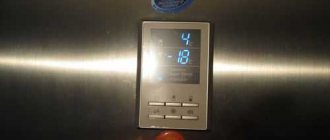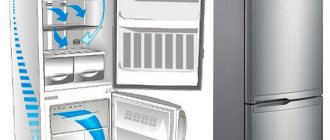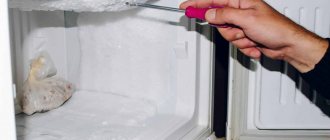Why does ice form under the drawers in the freezer?
The manual defrosting chamber is a cabinet with a double body, foamed with polyurethane. The inner chamber has structures made like stands for boxes or trays made of thin aluminum sheet. Evaporator tubes are connected to each shelf below.
Products are placed in drawers or behind doors. During freezing, water is released and settles on the tubes, which is why ice freezes under the drawers in the freezer. Therefore, it is dangerous to allow a large layer - it is difficult to remove products, and you can accidentally damage the tube.
Ice formation in the freezer compartment under the shelves is a natural physical process. But ice is an insulator and impairs heat transfer. The larger the snow build-up in the chamber, the longer the compressor cycle, and the more energy is spent on freezing food.
Uninvited guest: how does ice appear in the freezer? (2 photos)
1. Accumulation of ice and snow in a refrigerator with a No Frost system in the lower part of the freezer. There may be water accumulation under the drawers. These signs most likely indicate that the freezer drain hole is clogged. Under normal conditions, ice removal occurs once a day: the ice, turning into liquid, flows down the drainage channel. And if the hole is clogged, then the water has nowhere to go. It remains under the boxes and freezes, forming an ice crust. The drainage hole can be cleaned by rinsing with warm water poured into the syringe. But simply getting to it will not work in all cases. If you need to remove the back panel, it is better to seek help from a specialist.
2. The compressor operates almost without shutting down, the rear wall of the chamber is covered with a thick layer of snow and ice. The hazard indicator may flash and an error message may appear on electronically controlled models. Usually the cause of malfunction is the failure of the defrosting system. The breakdown of any of its elements prevents the unit from starting the defrosting cycle, as a result of which snow deposits actively and quickly grow. As a result, the refrigerator works worse, and the temperature in the freezer gradually increases. Trying to compensate for productivity, the motor-compressor operates almost without shutdowns. To eliminate the problem, it is necessary to diagnose the defrosting system and replace the failed unit.
3. The layer of ice is uniform, and large growths appear closer to the door. The temperature in the freezer compartment is increased. The alarm indicator may flash or an error message may appear (in the case of electronic models). Most often, these signs indicate a violation of the integrity of the seal, which causes depressurization of the chamber. The problem is solved by replacing it. Another possible cause could be an imbalance in the door mounting system.
4. The refrigerator almost never turns off. A uniform snow-ice coat forms on the walls of the chamber. Typically, such signs indicate a failure of the temperature sensor. Due to the violation, the control module receives incorrect information about the temperature in the chamber, causing the compressor to freeze more than necessary. The temperature sensor will need to be replaced.
5. The motor practically does not turn off. The temperature in the chamber is higher than necessary, and uneven ice forms in the evaporator area. After defrosting, both the freezer and the refrigerator may fail. In some cases, freon leakage is possible, as a result of which the performance of the device decreases, and a thick layer of ice forms at the leak site. After the freon has completely evaporated, one or both chambers will completely stop working. In such a situation, it is necessary to replace the evaporator and recharge the system with refrigerant.
The formation of ice and snow in the freezer indicates a breakdown. And prompt contact with a specialist will allow you to eliminate it in a timely manner, avoid failure of other components, save on repairs and quickly restore normal operation of the unit.
Why does ice form on the freezer door?
It happens that the alarm indicates a violation of the regime in the freezer - the door is not closed tightly or the seal has come off. Ice freezing is accelerating. Now it is loose, reminiscent of snow, wraps the lids of containers, and settles on the door. The cold passes through such a fur coat with difficulty, the compressor runs non-stop.
The reason for the accelerated freezing of ice in the freezer is the continuous supply of fresh air. The warm agent contains a lot of equilibrium moisture, which precipitates on cold surfaces. But frost frozen on the door widens the existing gap, increasing icing. A warm refrigerant circuit runs around the doorway in the foamed part. The ice melts, leaks under the bottom drawer, and ice forms on the bottom of the freezer.
If the freezer is electronically controlled, the regulator will stop distributing cold into the open circuit and the food will begin to thaw.
Why does ice form in the freezer?
If a Samsung, Bosch, Ariston or other brand refrigerator has a No Frost defrosting system and a snow coat freezes in the freezer, it is not necessarily a breakdown. You may be using the device incorrectly.
- Look at the control panel. Have you set the Super Freeze mode? In electromechanical models it is turned off manually. The compressor will pump out cold until you cancel the installation.
- Check the temperature regulator. The temperature in the chamber should be from -17 to -19 degrees. Otherwise, the compartment will become very cold, snow may form under the freezer, and the motor will wear out. Adjust the thermostat. Even if the room is too hot, do not set the temperature low - when the equipment is selected correctly, it will reach the required values on its own.
Minor problems include wear on the door seal. Warm air penetrates into the cracks, and the performance in the compartment increases. The compressor works with double load, pumping in cold, so snow freezes on the walls.
If the door is not closed tightly or the seal is leaking, a red light on the panel may flash or a signal may sound.
Tires need to be replaced. Perhaps it does not stick well to the body because it is clogged. You can wash it with warm water and soap, and wipe it with ammonia.
Sagging hinges also cause the door to not fit tightly. Then most of the ice will accumulate on the edge, near the freezer door. You can tighten the hinges yourself.
The red indicator blinks after the camera boots up. If you have placed a lot of warm food in the compartment, wait until the temperature returns.
Why does ice freeze in the freezer below?
It happens that food in the freezer thaws due to lack of or low voltage in the network. If the refrigerator turns on on its own after being idle, the resulting puddle may go unnoticed and freeze, creating ice under the freezer.
With the maximum freezing mode, when the door is opened, the frost melts and flows down in drops, where it freezes. You need to maintain an average temperature - less frost, economical energy consumption. By following the manufacturer's recommendations, you can ensure that ice does not accumulate at the bottom of the freezer.
Ice at the bottom of the No Frost freezer
If the freezer uses a convective method of transferring cold from the evaporator to the food, there should be no frost inside. The evaporator is located behind the panel in the cooling compartment, there is also a fan, a defrosting heating element and a hole for removing condensate from the circuit.
What happens is that the hole becomes clogged, the drainage hose freezes, sticks together, and water accumulates in the chamber with the evaporator, freezes in a lump, seeps into the working chamber, forming ice in the freezer. Soon, No Frost will become inoperable due to accumulated ice and a frozen fan. Sometimes the drops from behind the panel take a long time to roll down, and blocks of ice freeze directly in the trays in the freezer.
If the panels are cold, a thin layer of ice will freeze on the walls of the No Frost freezer. Gradually it will melt and drip onto the tray. What to do if ice freezes in the box? Turn off the refrigerator or freezer compressor, defrost the system and look for a malfunction.
Reasons for the formation of ice in the freezer and under the drawers of a No Frost refrigerator
A refrigerator with a No Frost system is the dream of any housewife. After all, according to the manufacturers, there is no ice in it, which means that such a unit does not require periodic defrosting (read more about defrosting the LG No Frost refrigerator), like its predecessors. As a rule, modern refrigerators have No Frost in both chambers - freezer and refrigerator. It would seem, use it, periodically only wiping the shelves and drawers, and know no grief. But, unfortunately, sometimes ice forms in No Frost. If you suddenly find snow in the freezer of your No Frost, don’t rush to be upset that you “fell for” the advertising: these models really work without the formation of an ice coat. But only if you have chosen the operating mode correctly and the refrigerator is in full working order.
First, let’s look at the most harmless option: when your refrigerator is in perfect order, but a very impressive “coat of snow” is growing in the freezer.
Super Freeze mode. Modern refrigerators have a fast freezing mode. It is used when it is necessary to quickly freeze a large volume of food. Most often, it turns off on its own after a day, but not in all models. Therefore, if you find ice in the freezer, check whether the “Super Freeze” mode is turned on.
Incorrect installation. Manufacturers recommend leaving a gap between the sides of the refrigerator (back, sides) and the surrounding furniture/walls of at least 5 cm. And from the top of the refrigerator to wall furniture - at least 10 cm. If you do not maintain the distance, the air will circulate poorly and heat will be removed from rear grille (condenser) of the refrigerator. Cooling performance will deteriorate, which can lead to constant operation and ice formation.
Incorrect cooling mode. Setting the freezing/cooling temperature lower during hot weather is another common user mistake that leads to ice formation. At a high temperature in the room, heat exchange between the condenser and the environment is already difficult, and with stronger cooling we force it to heat up even more.
If the temperature mode is chosen correctly, the installation is correct, but ice freezes in the No Frost freezer - unfortunately, we are talking about a breakdown.
The drain hole in the freezer of the No Frost refrigerator is clogged
This problem is characterized by accumulation of snow and ice from below. During normal operation of the No Frost system, the chambers are cleared of ice at least once a day. This happens as follows: to turn ice into water, a heating element is connected. The resulting water flows through the drainage system. But if the drainage hole is clogged, the water has nowhere to go. It remains under the boxes, freezing into thick blocks of ice.
To fix the problem, you need to clean the drainage. This can be done using warm water and a medical bulb or hand pump. However, unlike the refrigerator compartment, you will need to unscrew the back panel to access the freezer drain hole.
Malfunction of the temperature sensor in the No Frost refrigerator
With this problem, the walls become evenly covered with ice. If we are talking about two-compressor systems, only the freezer will freeze; if we are talking about single-compressor systems, the food in the refrigerator will also freeze.
The purpose of the temperature sensor is to measure the temperature in the chambers. If this element fails, the refrigerator receives incorrect data. Thus, thinking that the chambers are not cold enough, the compressor runs without stopping.
The insulation in the No Frost refrigerator is frozen
The body of the refrigeration cabinet is equipped with a heat-insulating layer. If used incorrectly or due to manufacturing defects, condensation will form in the walls. Moistened thermal insulation freezes and ice appears outside. Damaged areas of the protective layer are removed, replacing them with new material.
Wear of the rubber seal in the No Frost refrigerator
Due to long-term use or as a result of damage, the rubber around the perimeter of the door becomes unusable. As a result, the seal is lost and heat enters the chambers.
Characteristic signs of the problem: the “growths” are uneven and located closer to the door. The temperature in the cells is too high. On models with an electronic display, the corresponding error code may be displayed on the screen. A worn seal must be replaced.
Thermostat failure in the No Frost refrigerator
The sensor maintains the required temperature by starting and stopping the compressor. Electronically controlled refrigerators are equipped with air thermostats. The element determines the actual temperature in the compartments.
In mechanical refrigerators, a relay is installed, located near the evaporator. Voltage fluctuations and manufacturing defects contribute to part failure. Typical symptoms of a malfunction are:
- freezing of food in the refrigerator compartment;
- formation of an even layer of ice on the back wall;
- reducing the temperature in the refrigerator compartment;
- accumulation of water under the bottom drawers.
The relay must be removed and inspected. If signs of failure are detected, the element is replaced.
The door does not fit tightly in the No Frost refrigerator
Symptoms of the malfunction are similar to those that occur with a worn seal. The reason for the phenomenon is the same: a violation of the tightness of the chambers.
As you know, the door is hinged. If the hinges sag or become loose, the seal of the chambers is broken. The door position needs to be adjusted.
Evaporator heating element in the No Frost refrigerator
As a result of sudden voltage surges or a short circuit in the electrical network of the device, the heating element of the evaporator may fail. In this state, warm air will enter the chamber when the door is opened, the compressor will begin to compensate for the lack of cold, freezing over and over again an increasingly thick layer of ice, while this frost will not be able to thaw. As a result, you may notice icing on the back wall or shelf of the freezer. In this situation, only replacing the heating element will help.
Refrigerant leak in No Frost refrigerator
When freon leaks, the cooling performance drops. The compressor, trying to make up for the deficiency, initially works without stopping. The engine will not turn on at all after the gas has completely evaporated. When there is a refrigerant leak, ice is usually located in the area of the freezer evaporator.
Solenoid valve in the No Frost refrigerator
This component is designed to switch cooling modes between two chambers - freezing and refrigerating. In particular, old-style single-compressor refrigerators are equipped with such a unit. The solenoid valve reacts by switching two modes:
- simultaneous cooling of the freezer and refrigerator compartment;
- Cooling only in the freezer.
If the valve is faulty or stuck in the simultaneous cooling mode, there may be an increase in temperature in the freezer, and food in the refrigerator compartment will freeze due to a decrease in temperature, often below 0 degrees Celsius.
Incorrect installation of the No Frost refrigerator
Manufacturers of household appliances recommend leaving at least 5 cm of free space between the refrigerator and the back wall. Otherwise, there will be improper air exchange in the refrigerator. In other words, heat will not be removed from the back wall of the refrigerator. Consequently, the refrigerator will freeze poorly and dissipate heat poorly. This can lead to ice formation
Malfunction of the defrost system in the No Frost refrigerator
The Full No Frost system (no ice in both chambers) is designed as follows. The evaporator is located in the freezer compartment on the rear wall. It cools the freezer. Near it there is a fan and air channels. Through them, a fan drives cold air from the evaporator into the refrigerator compartment. The cooling level of the refrigerator compartment is regulated by the air flow, which is blocked by a special damper. Behind the evaporator there is a heating element (heater) for defrosting. As it cools, frost forms on the evaporator, which regularly thaws when the heater is turned on. The water formed as a result of defrosting goes through the drainage channel into a bath located on the refrigerator compressor. As a result, the refrigerator freezes, but no snow coat forms in it. However, only if everything works properly.
Note! According to the experience of RemBytTech specialists, every second request from No Frost owners is associated with a failure of the defrost system. Since the evaporator is hidden behind a panel in the freezer, the user usually detects a malfunction not by frozen ice in the freezer, but by the lack of cold in the refrigerator. The formed ice blocks the air channels, and cooled air stops flowing into the refrigerator compartment. This is what users notice first: it becomes too “warm” in the main compartment.
Any housewife can determine that the defrosting system has failed. When the refrigerator compartment has stopped cooling and you find ice on the back wall of the freezer, follow these steps:
- Defrost the refrigerator by unplugging it for 12-24 hours. Food must be removed from the freezer.
- Turn the refrigerator back on.
If after defrosting the main compartment becomes cold again, then your defrost is faulty.
The fact is that during prolonged defrosting, the ice that prevents the passage of cold air from the evaporator into the refrigeration compartment melts and cooling is restored. However, since the defrost does not work, this effect is temporary, after 1-2 weeks the problem will recur again.
Note! If you have identified a malfunction of the No Frost defrost, do not hesitate to call a technician. Firstly, defrosting the refrigerator every two weeks is not very convenient. And secondly, the resulting ice can block and damage the fan, which drives cooled air from the evaporator into the refrigerator compartment. And then you will have to not only repair the defrost system, but also replace the fan.
Ice forms in the freezer compartment of a Samsung refrigerator
Many users of modern double-chamber Samsung refrigerators complain on forums that with No Frost they often have to defrost the refrigerator. The evaporator constantly freezes and the fan stops. First, the water drains downwards, which is why ice forms at the bottom of the No Frost freezer. Then the defrost continues to work, but ice accumulates below, covering the evaporator. The reason for the formation of ice in the Samsung freezer is known to experts.
The air labyrinths behind the panels completely freeze. It is necessary to defrost the device for 2 days and start it again. If it doesn’t help, defrost it again and clean the drainage behind the panel. At the same time, you need to make sure that the drain hole is located above the condensate tray and that the hose is not stuck together. Freezing of the drainage tube is the main reason for the appearance of ice in the freezer compartment of a Samsung refrigerator.
Why does ice form?
There are several reasons why ice and snow form in the freezer compartment of a Samsung No Frost refrigerator:
- Damage to the rubber seal, which causes the door to seal against the chamber.
- The evaporator tubes are damaged. It is also possible that they become clogged, intact, or the seals of the connections are compromised. If damaged, water may enter the freezer compartment and become ice. To eliminate the malfunction yourself, it is possible to clean the drain or restore the tightness of the connections.
- The heating element is damaged; a qualified technician can handle this damage.
- The No frost system is damaged, which can only be dealt with by a technician who knows the typical breakdowns of this system.
Important! Ice can form during periodic power outages. In any case, to find out the cause, the help of a specialist is required. If this is the reason, find out how to choose a voltage stabilizer for your refrigerator.
Important! Very often, the refrigerator collects various odors from the products stored in it. An odor absorber can cope with this problem.











